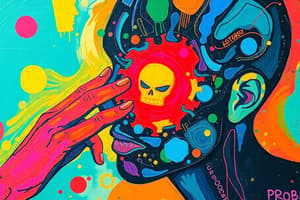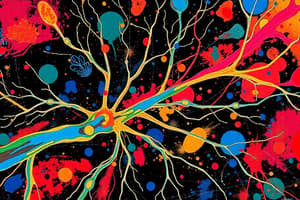Podcast
Questions and Answers
Which type of nerve fibres are responsible for transmitting sharp somatic pain?
Which type of nerve fibres are responsible for transmitting sharp somatic pain?
- C-fibres
- Alpha Beta Fibres
- A-beta Fibres
- Alpha-delta (aδ) Fibres (correct)
What is the primary function of C-fibres in the context of pain perception?
What is the primary function of C-fibres in the context of pain perception?
- Carrying visceral pain signals (correct)
- Conducting sharp, localized pain signals
- Transmitting touch and pressure information
- Facilitating reflex actions
Which tract is primarily involved in transmitting pain and temperature sensations to the cerebral cortex?
Which tract is primarily involved in transmitting pain and temperature sensations to the cerebral cortex?
- Corticospinal Tract
- Spinothalamic Tract (correct)
- Dorsal Column
- Spinocerebellar Tract
In pain pathways, what is the role of the dorsal root ganglion?
In pain pathways, what is the role of the dorsal root ganglion?
What characterizes the conduction velocity of Alpha Beta Fibres?
What characterizes the conduction velocity of Alpha Beta Fibres?
Which of the following is the correct order of neurons in the pain pathway leading to the cerebral cortex?
Which of the following is the correct order of neurons in the pain pathway leading to the cerebral cortex?
Which statement best describes the function of the Spinocerebellar tract?
Which statement best describes the function of the Spinocerebellar tract?
What distinguishes the decussation of pain signals in the nervous system?
What distinguishes the decussation of pain signals in the nervous system?
Which type of pain is characterized as diffuse and poorly localized?
Which type of pain is characterized as diffuse and poorly localized?
Which neuron is responsible for transmitting signals to the somatosensory cortex?
Which neuron is responsible for transmitting signals to the somatosensory cortex?
What role does the periaqueductal grey matter (PAG) play in pain modulation?
What role does the periaqueductal grey matter (PAG) play in pain modulation?
What substances are released by activated interneurons during pain modulation?
What substances are released by activated interneurons during pain modulation?
What is the primary function of the descending pathway in pain processing?
What is the primary function of the descending pathway in pain processing?
Where do most upper motor neurons decussate (cross over) in the neural pathway?
Where do most upper motor neurons decussate (cross over) in the neural pathway?
How does serotonin contribute to pain modulation in the spinal cord?
How does serotonin contribute to pain modulation in the spinal cord?
What defines the difference between upper motor neurons (UMN) and lower motor neurons (LMN)?
What defines the difference between upper motor neurons (UMN) and lower motor neurons (LMN)?
What is the primary function of endogenous opioids in the pain pathway?
What is the primary function of endogenous opioids in the pain pathway?
What happens once the upper motor neuron (UMN) reaches the correct vertebral level?
What happens once the upper motor neuron (UMN) reaches the correct vertebral level?
Which neurotransmitter is primarily involved in the excitatory connection with inhibitory interneurons in the pain pathway?
Which neurotransmitter is primarily involved in the excitatory connection with inhibitory interneurons in the pain pathway?
What is a common sign of upper motor neuron lesions?
What is a common sign of upper motor neuron lesions?
Which of the following best describes lower motor neuron syndrome?
Which of the following best describes lower motor neuron syndrome?
What is a potential consequence of anterior spinal artery occlusion?
What is a potential consequence of anterior spinal artery occlusion?
Dorsal root ganglia are primarily associated with which type of neurons?
Dorsal root ganglia are primarily associated with which type of neurons?
What characteristic is most associated with spasticity in upper motor neuron lesions?
What characteristic is most associated with spasticity in upper motor neuron lesions?
Which structure is involved in providing relay points between different neurological structures?
Which structure is involved in providing relay points between different neurological structures?
What is a significant impact of lower motor neuron lesions on muscle function?
What is a significant impact of lower motor neuron lesions on muscle function?
What type of fibers are found in autonomic ganglia?
What type of fibers are found in autonomic ganglia?
What reflex is associated with upper motor neuron lesions?
What reflex is associated with upper motor neuron lesions?
Which of the following statements about the spinal cord's blood supply is false?
Which of the following statements about the spinal cord's blood supply is false?
What is the primary role of decussation in the nervous system?
What is the primary role of decussation in the nervous system?
Which type of neuron is primarily responsible for transmitting pain signals from peripheral tissues to the central nervous system?
Which type of neuron is primarily responsible for transmitting pain signals from peripheral tissues to the central nervous system?
In pain modulation, which mechanism involves the alteration of pain perception through the release of endogenous opioids?
In pain modulation, which mechanism involves the alteration of pain perception through the release of endogenous opioids?
Which statement most accurately describes ascending pathways in the nervous system?
Which statement most accurately describes ascending pathways in the nervous system?
Where does the spinal cord typically end in adults, and why is this significant?
Where does the spinal cord typically end in adults, and why is this significant?
What is the function of the cauda equina in relation to nerve roots?
What is the function of the cauda equina in relation to nerve roots?
Which system is fully reversed regarding lateralization of function in the processing of sensory input?
Which system is fully reversed regarding lateralization of function in the processing of sensory input?
What is a key characteristic of the gray matter in the spinal cord?
What is a key characteristic of the gray matter in the spinal cord?
Which type of information does the peripheral nervous system primarily relay to the central nervous system?
Which type of information does the peripheral nervous system primarily relay to the central nervous system?
What potential consequence results from compression of the cauda equina nerves?
What potential consequence results from compression of the cauda equina nerves?
Flashcards are hidden until you start studying
Study Notes
The Nervous System and Pain
- The nervous system is responsible for transmitting information about pain to the brain.
- Pain is caused by the activation of nociceptors, which are specialized sensory receptors that detect harmful stimuli.
- Three orders of neurons carry pain signals from the periphery to the cerebral cortex:
- First order neuron: Located in the dorsal root ganglion, synapses with the second order neuron.
- Second order neuron: Travels along the spinothalamic tract and synapses in the thalamus.
- Third order neuron: Sends fibers to the somatosensory cortex, where pain is perceived.
- Alpha Beta Fibres are large, myelinated, and carry information related to touch/pressure and localized pain.
- Alpha-delta (aδ) fibres are small and myelinated and conduct sharp pain.
- C-fibres are the smallest, non-myelinated and conduct slowly, causing diffuse pain.
- Descending pathway helps inhibit pain.
- Periaquaductal grey matter (PAG) plays a role in pain modulation.
- Enkephalin-releasing neurons are involved in pain inhibition.
- Serotonin descends to the dorsal horn of the spinal cord and forms excitatory connections with inhibitory interneurons, which release enkephalins or dynorphin to bind to mu opioid receptors.
- Endogenous and exogenous Opioid can inhabit the first order neurone by blocking neurotransmitters. Morphine is an example of an exogenous opioid which can inhibit pain signaling.
- Upper motor neurons (UMN) transmit signals from the brain to the brainstem and spinal cord.
- Lower motor neurons (LMN) transmit signals from the spinal cord to muscles.
- UMN lesions can cause weakness or paralysis of specific movements, spasticity, hyperreflexia, and Babinski reflex.
- LMN lesions can cause weakness or paralysis individual muscles, wasting of muscles, fasciculation, hypotonia, hyporeflexia or areflexia.
Blood Supply to the Spinal Cord
- The anterior and posterior spinal arteries supply blood to the spinal cord.
- Radicular arteries provide additional blood flow to the spinal cord.
- The thoracic region and anterior portion of the spinal cord are most vulnerable to occlusion.
- Anterior spinal cord occlusion can cause paraplegia and incontinence.
Venous Drainage of the Spinal Cord
- Anterior and posterior spinal veins drain the spinal cord.
- Spinal veins connect to the internal vertebral venous plexus and drain into lumbar veins, azygos and hemiazygos veins.
Ganglions
- A ganglion is a cluster of nerve cell bodies.
- Ganglions house cell bodies of afferent and efferent nerve fibers.
- Ganglions can connect with other ganglia forming complex systems called plexuses.
- Ganglions act as relay points between different neurological structures.
- Examples include:
- Dorsal root ganglia (spinal ganglia): Sensory neurones
- Cranial nerve ganglia: Cell bodies of cranial neurones
- Autonomic ganglia: Cell bodies of autonomic nerves
Spinal Cord Anatomy
- The spinal cord is located within the vertebral canal.
- It extends from the brainstem and receives information from and controls the trunk and limbs.
- The spinal cord has a H-shaped gray matter core surrounded by white matter.
- Intervertebral foramina are openings in the vertebral column where spinal nerves leave the spinal cord
- The cauda equina is a bundle of lumbar and sacral nerves which extend from the end of the spinal cord.
- The spinal cord ends at the L1/L2 disc.
The Cauda Equina Syndrome
- The cauda equina syndrome results in pressure on the nerves of the cauda equina.
- This pressure can cause:
- Bowel control loss
- Numbness, weakness
- Pain
Decussation
- Decussation is the crossing over of nerve fibers from one side of the body to the other.
- Most nerve fibers decussate at the medulla.
- Exceptions to decussation:
- Olfactory system is not reversed at all.
- Visual system is only partially reversed.
- Auditory system is analyzed on both sides of the lower brain, but only one side of the cortex.
Studying That Suits You
Use AI to generate personalized quizzes and flashcards to suit your learning preferences.




